#akkadian text
Explore tagged Tumblr posts
Link
The program is most effective when translating sentences of 118 or fewer characters. In some of the sentences, the program produced “hallucinations” – output that was syntactically correct in English but not accurate.
Gordin noted that in most cases, the translation would be usable as a first-pass at the text. The authors propose that machine translation can be used as part of a “human-machine collaboration,” in which human scholars correct and refine the models’ output.
Hundreds of thousands of clay tablets inscribed in the cuneiform script document the political, social, economic and scientific history of ancient Mesopotamia, they wrote. “Yet, most of these documents remain untranslated and inaccessible due to their sheer number and the limited quantity of experts able to read them.”
They concluded that translation is a fundamental human activity, with a long scholarly history since the beginning of writing. “It can be a complex process, since it commonly requires not only expert knowledge of two different languages but also different cultural milieus. Digital tools that can assist with translation are becoming more ubiquitous every year, tied to advances in fields like optical character recognition (OCR) and machine translation. Ancient languages, however, still pose a towering problem in this regard. Their reading and comprehension require knowledge of a long-dead linguistic community, and moreover, the texts themselves can also be very fragmentary.”
15 notes
·
View notes
Text


Sophus Helle, Gilgamesh — tablet X, line 55 Dead Boy Detectives (2024) — season 01, episode 07
#dead boy detectives#dbda#charles rowland#edwin payne#jayden revri#george rexstrew#dbdagifs#mygifs#myedits#dbdaedits#dbda and gilgamesh#once again i apologize to any babylonian sumerian or akkadian scholars in the fandom#i'm doing my utmost best#cross referencing like 3 different texts and 4 different dictionaries including ePSD#just to maybe get one cuneiform character right#and i'm less confident about this one than the last set that had cuneiform#anyway for those of you interested#the first gif has the word for “love”#which according to george (2003) was probably part of the word a-ram-mu-šú in line 55#love being râmu#and as far as i can tell that's a pretty strong word for love that sounds pretty damn romantic#and then in the second gif#it's the word for “sick” but i'm pretty sure in this context it's the word translated as “danger” and means a bit more like “troubles”#which again thanks to george (2003) is probably part of the word mar-ṣa-a-ti in this line#and sick/troublesome/difficult is marṣu#anyway i did all this research at like 1:30am so it's probably deeply flawed but whatever#it's a gif for a tv show#it can have incorrect cuneiform and the only one who really cares is me
335 notes
·
View notes
Text
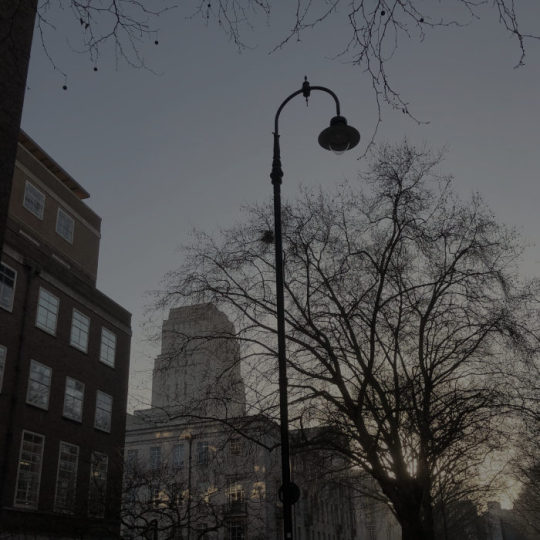



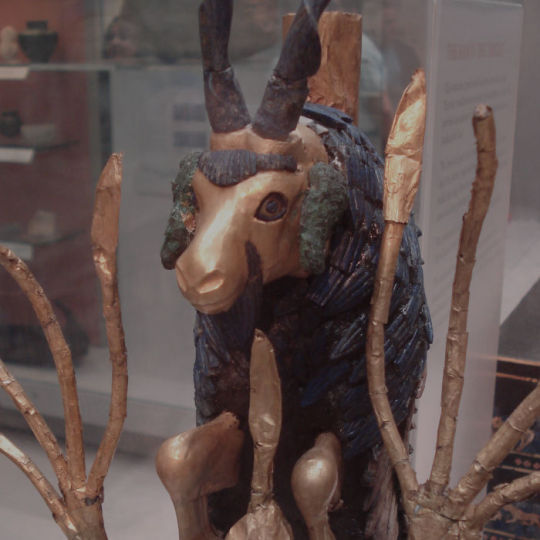

𒀜𒋫𒋫𒀜𒁕𒇷𒅁𒈪𒈾𒀀𒋫𒀠𒄣 𒀸𒁕𒆷𒉿𒌅𒌦𒈾𒄩𒊏𒌋𒌋𒅗
Epic of Gilgameš X.297-8
("you kept toiling ceaselessly without sleep. what did you get? / you are exhausting yourself with ceaseless toil")
#dark academia post from an alternate reality where donna tartt studied ancient mesopotamia instead of classics#what if the dark academia ur-text was actually about Ur?#ninhurtag#dark academia#dark acadamia aesthetic#chaotic academia#grey academia#dark aesthetic#akkadian#sumerian#mesopotamia#gilgamesh#studyblr#moodboard#ἐποίησα
142 notes
·
View notes
Text
Can't believe that my fucking train is once again running 1 hour late because someone stole all the fucking copper from the railway line like omg stoooppp why are u so silly ahah stop making this prank it's too epic ahahah
#wren text tag#Epic Trenitalia Moment#also why the fuck are you stealing the copper?#are you that fucking merchant Ea-Nasir???#do I have to write you a complaint on a fucking clay tablet?#in the Akkadian Cuneiform alphabet?
3 notes
·
View notes
Text
nobody will understand this but: FUCK YOU CUSAS 30 by van soldt
#i hate this catalogue so much......#is it really so difficult to study PROPERLY kassite texts#the struggle of prosopography#especially akkadian prosopography#help.#sothis ships dimileth
0 notes
Text

Down a Rabbit Hole I Went
I screwed up. I didn't think that using an ancient language on a piece of tumblr merch was necessary but I forgot what site I was on :) . This is tumblr, of course it has to be in linguistically accurate cuneiform. I went and hired an expert on Ancient Semitic Languages and Cultures. There aren't as many as you'd think that are willing to translate text for an internet gag so I'm so happy I found Paul.

Notes on the translation from the translator:
I used the ventive suffix on the imperative "give (rib+am)" which is a special feature of Akkadian that indicates the motion of direction. It makes it a little bit more authentic. The longer version actually includes the words "to me (ana iasim)", but a typical Akkadian speaker probably wouldn't have needed to say that.
Also, for the word "money" I used the Sumerian (KUG.BABBAR) instead of spelling out the Akkadian, because that was a common feature in Akkadian scribal writing. For the font I was happily surprised that Google has a Cuneiform font, so not only is it correct but it looks pretty neat too. Right now you can buy both versions in the shop but cuneiform version won't ship for a week or so as I have to order new stock with the new design.
22K notes
·
View notes
Photo
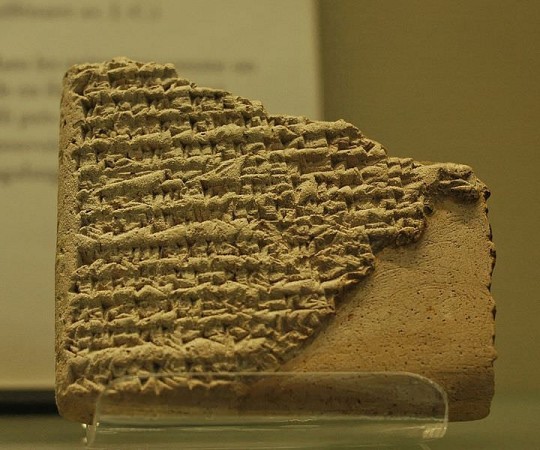
The Legend of Sargon of Akkad
The Legend of Sargon of Akkad (c. 2300 BCE) is an Akkadian work from Mesopotamia understood as the autobiography of Sargon of Akkad (Sargon the Great, r. 2334-2279 BCE), founder of the Akkadian Empire. The earliest copy is dated to the 7th century BCE and was found in the ruins of the Library of Ashurbanipal in the 19th century.
The text, most likely composed c. 2300 BCE, and also known as The Birth Legend of Sargon, describes the king's humble origins and rise to power with the help of the goddess Ishtar and concludes with a challenge to future kings to go where he has gone and do as he has done. Sargon was the founder of the first multinational empire in the world whose reign became legendary, inspiring many tales about him, but very little is known of his life apart from works such as The Legend of Sargon of Akkad and the literary piece Sargon and Ur-Zababa.
Both pieces today are sometimes classified as belonging to the genre of Mesopotamian naru literature – the world's first historical fiction – in which a famous figure, usually a king, is featured as the main character in a fictional work. This genre appeared around the 2nd millennium BCE and was quite popular, as evidenced by the number of copies found of naru works.
The purpose of naru literature was not to deceive an audience but to impress upon them some important religious or cultural value. In the case of The Legend of Sargon of Akkad, however, the naru genre seems to have been used to establish Sargon as a 'man of the people' who, beginning life as an orphan with nothing, forged his own destiny and established an empire.
The Legend & Naru Literature
Sargon of Akkad was keenly aware of his times and the people he would rule over. He seems to have understood, early on, that the common people resented the nobility and, while he was clearly a brilliant military leader, it was the story he told of his youth and rise to power that exerted a powerful influence over the Sumerians he sought to conquer.
Instead of representing himself as a man chosen by the gods to rule, he presented a more modest image of himself as an orphan set adrift in life who was taken in by a kind gardener and granted the love of the goddess Inanna/Ishtar. According to The Legend of Sargon of Akkad, he was born the illegitimate son of a "changeling", which could refer to a temple priestess of Ishtar (whose clergy were androgynous) and never knew his father.
His mother could not reveal her pregnancy or keep the child, and so she placed him in a basket which she then set adrift on the Euphrates River. She had sealed the basket with tar, and the water carried him safely to where he was later found by a man named Akki, a gardener for Ur-Zababa, the king of the Sumerian city of Kish. In creating this legend, Sargon carefully distanced himself from the kings of the past (who claimed divine right) and aligned himself with the common people of the region rather than the ruling elite.
The Legend, as noted, is considered by some scholars today as belonging to the genre of Mesopotamian naru literature, but it is unknown whether it would have been understood that way in its time. Scholar O. R. Gurney defines the genre and its origin:
A naru was an engraved stele, on which a king would record the events of his reign; the characteristic features of such an inscription are a formal self-introduction of the writer by his name and titles, a narrative in the first person, and an epilogue usually consisting of curses upon any person who might in the future deface the monument and blessings upon those who should honour it. The so-called "naru literature" consists of a small group of apocryphal naru-inscriptions, composed probably in the early second millennium B.C., but in the name of famous kings of a bygone age. A well-known example is the Legend of Sargon of Akkad. In these works, the form of the naru is retained, but the matter is legendary or even fictitious. (93)
The extant copy, made long after Sargon's death, conveys the story Sargon would have presented regarding his birth, upbringing, and reign. Naru pieces such as The Legend of Cutha or The Curse of Agade use a well-known historical figure (in both these cases Naram-Sin, Sargon's grandson) to make a point concerning the proper relationship between a human being (especially a king) and the gods. Other naru literature, such as The Great Revolt and The Legend of Sargon of Akkad, tell a tale of a great king's military victory or origin. In Sargon's case, it would have been to his benefit, as an aspiring conqueror and empire builder, to claim for himself a humble birth and modest upbringing.
Continue reading...
145 notes
·
View notes
Text
A world without trans people has never existed and it never will.

Seriously just search (Trans History).
Here are some examples:
"Sumerian and Akkadian texts from 4,500 years ago document priests known as gala who may have been transgender. In Ancient Greece, Phrygia, and Rome, there were galli priests that some scholars believe to have been trans women.
Roman emperor Elagabalus (d. 222 AD) preferred to be called a lady (rather than a lord) and sought sex reassignment surgery, and in the modern day has been seen as a trans figure.
Hijras on the Indian subcontinent and kathoeys in Thailand have formed trans-feminine third gender social and spiritual communities since ancient times, with their presence documented for thousands of years in texts which also mention trans male figures. Today, at least half a million hijras live in India and another half million in Bangladesh, legally recognized as a third gender, and many trans people are accepted in Thailand.
In Arabia, khanith today (like earlier mukhannathun) fulfill a third gender role attested since the AD 600s.
In Africa, many societies have traditional roles for trans women and trans men, some of which survive in the modern era.
In the Americas prior to European colonization, as well as in some contemporary North American Indigenous cultures, there are social and ceremonial roles for third gender people, or those whose gender expression transforms, such as the Navajo nádleehi or the Zuni lhamana."
In conclusion. Being trans is not a fad and it isn't going anywhere just because some crazy religious nut jobs say we don't fit into their abusive hateful world views. We are here and always will be. So get used to it. 👋😘
#lgbtq#trans#transmasc#trans masc#transfem#transgender#trans woman#transgirl#lgbtqia#trans rights are human rights#trans rights
3K notes
·
View notes
Note
hi mr sawyer! i have a couple questions on the eoran languages
do the languages contain grammatical structures?
what are the different languages' real-world basises? for example, i recognize the influence of other celtic languages (i.e. alphabets) on some of the engwithan text here, but the language largely corresponds to irish.
thank you for your time!
Hello. While the Eoran conlangs don't have fully developed grammar, they do borrow elements from real world languages.
Eld Aedyran borrows vocabulary and grammar from Old English and Icelandic.
Glanfathan uses a lot of Cornish vocabulary, but also some Welsh and Irish.
Vailian is a blend of Italian, Occitan, and French but with inflected grammar.
Huana is dominantly Māori but with a few elements of Japanese.
Seki is based on Akkadian.
Engwithan is inspired by Gaulish.
154 notes
·
View notes
Text
The most important deity you've never heard of: the 3000 years long history of Nanaya
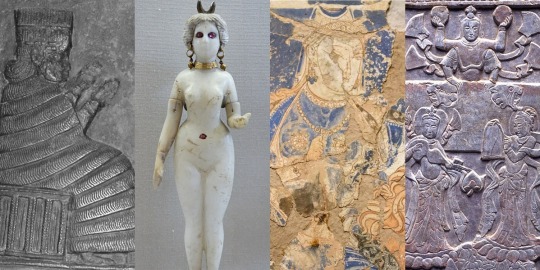
Being a major deity is not necessarily a guarantee of being remembered. Nanaya survived for longer than any other Mesopotamian deity, spread further away from her original home than any of her peers, and even briefly competed with both Buddha and Jesus for relevance. At the same time, even in scholarship she is often treated as unworthy of study. She has no popculture presence save for an atrocious, ill-informed SCP story which can’t get the most basic details right. Her claims to fame include starring in fairly explicit love poetry and appearing where nobody would expect her. Therefore, she is the ideal topic to discuss on this blog. This is actually the longest article I published here, the culmination of over two years of research. By now, the overwhelming majority of Nanaya-related articles on wikipedia are my work, and what you can find under the cut is essentially a synthesis of what I have learned while getting there. I hope you will enjoy reading it as much as I enjoyed working on it. Under the cut, you will learn everything there is to know about Nanaya: her origin, character, connections with other Mesopotamian deities, her role in literature, her cult centers… Since her history does not end with cuneiform, naturally the later text corpora - Aramaic, Bactrian, Sogdian and even Chinese - are discussed too. The article concludes with a short explanation why I see the study of Nanaya as crucial.
Dubious origins and scribal wordplays: from na-na to Nanaya Long ago Samuel Noah Kramer said that “history begins in Sumer”. While the core sentiment was not wrong in many regards, in this case it might actually begin in Akkad, specifically in Gasur, close to modern Kirkuk. The oldest possible attestation of Nanaya are personal names from this city with the element na-na, dated roughly to the reign of Naram-Sin of Akkad, so to around 2250 BCE. It’s not marked in the way names of deities in personal names would usually be, but this would not be an isolated case.
The evidence is ultimately mixed. On one hand, reduplicated names like Nana are not unusual in early Akkadian sources, and -ya can plausibly be explained as a hypocoristic suffix. On the other hand, there is not much evidence for Nanaya being worshiped specifically in the far northeast of Mesopotamia in other periods. Yet another issue is that there is seemingly no root nan- in Akkadian, at least in any attested words.
The main competing proposal is that Nanaya originally arose as a hypostasis of Inanna but eventually split off through metaphorical mitosis, like a few other goddesses did, for example Annunitum. This is not entirely implausible either, but ultimately direct evidence is lacking, and when Nanaya pops up for the first time in history she is clearly a distinct goddess.
There are a few other proposals regarding Nanaya’s origin, but they are considerably weaker. Elamite has the promising term nan, “day” or “morning”, but Nanaya is entirely absent from the Old Elamite sources you’d expect to find her in if Mesopotamians imported her from the east. Therefore, very few authors adhere to this view. The hypothesis that she was an Aramaic goddess in origin does not really work chronologically, since Aramaic is not attested in the third millennium BCE at all. The less said about attempts to connect her to anything “Proto-Indo-European”, the better.
Like many other names of deities, Nanaya’s was already a subject of etymological speculation in antiquity. A late annotated version of the Weidner god list, tablet BM 62741, preserves a scribe’s speculative attempt at deriving it from the basic meaning of the sign NA, “to call”, furnished with a feminine suffix, A. Needless to say, like other such examples of scribal speculation, some of which are closer to playful word play than linguistics, it is unlikely to reflect the actual origin of the name.
Early history: Shulgi-simti, Nanaya’s earliest recorded #1 fan
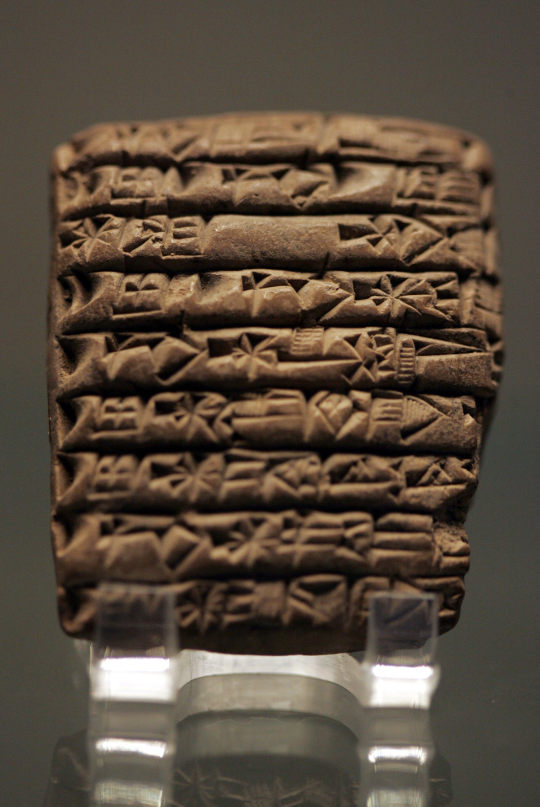
A typical Ur III administrative tablet listing offerings to various deities (wikimedia commons)
The first absolutely certain attestations of Nanaya, now firmly under her full name, have been identified in texts from the famous archive from Puzrish-Dagan, modern Drehem, dated to around 2100 BCE. Much can be written about this site, but here it will suffice to say that it was a center of the royal administration of the Third Dynasty of Ur ("Ur III") responsible for the distribution of sacrificial animals. Nanaya appears there in a rather unique context - she was one of the deities whose cults were patronized by queen Shulgi-simti, one of the wives of Shulgi, the successor of the dynasty’s founder Ur-Namma. We do not know much about Shulgi-simti as a person - she did not write any official inscriptions announcing her preferred foreign policy or letters to relatives or poetry or anything else that typically can be used to gain a glimpse into the personal lives of Mesopotamian royalty. We’re not really sure where she came from, though Eshnunna is often suggested as her hometown. We actually do not even know what her original name was, as it is assumed she only came to be known as Shulgi-simti after becoming a member of the royal family. Tonia Sharlach suggested that the absence of information about her personal life might indicate that she was a commoner, and that her marriage to Shulgi was not politically motivated The one sphere of Shulgi-simti’s life which we are incredibly familiar with are her religious ventures. She evidently had an eye for minor, foreign or otherwise unusual goddesses, such as Belet-Terraban or Nanaya. She apparently ran what Sharlach in her “biography” of her has characterized as a foundation. It was tasked with sponsoring various religious celebrations. Since Shulgi-simti seemingly had no estate to speak of, most of the relevant documents indicate she procured offerings from a variety of unexpected sources, including courtiers and other members of the royal family. The scale of her operations was tiny: while the more official religious organizations dealt with hundreds or thousands of sacrificial animals, up to fifty or even seventy thousand sheep and goats in the case of royal administration, the highest recorded number at her disposal seems to be eight oxen and fifty nine sheep. A further peculiarity of the “foundation” is that apparently there was a huge turnover rate among the officials tasked with maintaining it. It seems nobody really lasted there for much more than four years. There are two possible explanations: either Shulgi-simti was unusually difficult to work with, or the position was not considered particularly prestigious and was, at the absolute best, viewed as a stepping stone. While the Shulgi-simti texts are the earliest evidence for worship of Nanaya in the Ur III court, they are actually not isolated. When all the evidence from the reigns of Shulgi and his successors is summarized, it turns out that she quickly attained a prominent role, as she is among the twelve deities who received the most offerings. However, her worship was seemingly limited to Uruk (in her own sanctuary), Nippur (in the temple of Enlil, Ekur) and Ur. Granted, these were coincidentally three of the most important cities in the entire empire, so that’s a pretty solid early section of a divine resume. She chiefly appears in two types of ceremonies: these tied to the royal court, or these mostly performed by or for women. Notably, a festival involving lamentations (girrānum) was held in her honor in Uruk. To understand Nanaya’s presence in the two aforementioned contexts, and by extension her persistence in Mesopotamian religion in later periods, we need to first look into her character.
The character of Nanaya: eroticism, kingship, and disputed astral ventures

Corona Borealis (wikimedia commons)
Nanaya’s character is reasonably well defined in primary sources, but surprisingly she was almost entirely ignored in scholarship quite recently. The first study of her which holds up to scrutiny is probably Joan Goodnick Westenholz’s article Nanaya, Lady of Mystery from 1997. The core issue is the alleged interchangeability of goddesses. From the early days of Assyriology basically up to the 1980s, Nanaya was held to be basically fully interchangeable with Inanna. This obviously put her in a tough spot. Still, over the course of the past three decades the overwhelming majority of studies came to recognize Nanaya as a distinct goddess worthy of study in her own right. You will still stumble upon the occasional “Nanaya is basically Inanna”, but now this is a minority position. Tragically it’s not extinct yet, most recently I’ve seen it in a monograph published earlier this year. With these methodological and ideological issues out of the way, let’s actually look into Nanaya’s character, as promised by the title of this section. Her original role was that of a goddess of love. It is already attested for her at the dawn of her history, in the Ur III period. Her primary quality was described with a term rendered as ḫili in Sumerian and kuzbu in Akkadian. It can be variously translated as “charm”, “luxuriance”, “voluptuousness”, “sensuality” or “sexual attractiveness”. This characteristic was highlighted by her epithet bēlet kuzbi (“lady of kuzbu”) and by the name of her cella in the Eanna, Eḫilianna. The connection was so strong that this term appears basically in every single royal inscription praising her. She was also called bēlet râmi, “lady of love”. Nanaya’s role as a love goddess is often paired with describing her as a “joyful” or “charming” deity. It needs to be stressed that Nanaya was by no metric the goddess of some abstract, cosmic love or anything like that. Love incantations and prayers related to love are quite common, and give us a solid glimpse into this matter. Nanaya’s range of activity in them is defined pretty directly: she deals with relationships (and by extension also with matters like one-sided crushes or arguments between spouses), romance and with strictly sexual matters. For an example of a hymn highlighting her qualifications when it comes to the last category, see here. The text is explicit, obviously. We can go deeper, though. There is also an incantation whose incipit at first glance leaves little to imagination:

However, the translator, Giole Zisa, notes there is some debate over whether it’s actually about having sex with Nanaya or merely about invoking her (and other deities) while having sex with someone else. A distinct third possibility is that she’s not even properly invoked but that “oh, Nanaya” is simply an exclamation of excitement meant to fit the atmosphere, like a specialized version of the mainstay of modern erotica dialogue, “oh god”.
While this romantic and sexual aspect of Nanaya’s character is obviously impossible to overlook, this is not all there was to her. She was also associated with kingship, as already documented in the Ur III period. She was invoked during coronations and mourning of deceased kings. In the Old Babylonian period she was linked to investiture by rulers of newly independent Uruk. A topic which has stirred some controversy in scholarship is Nanaya’s supposed astral role. Modern authors who try to present Nanaya as a Venus deity fall back on rather faulty reasoning, namely asserting that if Nanaya was associated with Inanna and Inanna personified Venus, clearly Nanaya did too. Of course, being associated with Inanna does not guarantee the same traits. Shaushka was associated with her so closely her name was written with the logogram representing her counterpart quite often, and lacked astral aspects altogether. No primary sources which discuss Nanaya as a distinct, actively worshiped deity actually link her with Venus. If you stretch it you will find some tidbits like an entry in a dictionary prepared by the 10th century bishop Hasan bar Bahlul, who inexplicably asserted Nanaya was the Arabic name of the planet Venus. As you will see soon, there isn’t even a possibility that this reflected a relic of interpretatio graeca. The early Mandaean sources, many of which were written when at least remnants of ancient Mesopotamian religion were still extant, also do not link Nanaya with Venus. Despite at best ambivalent attitude towards Mesopotamian deities, they show remarkable attention to detail when it comes to listing their cult centers, and on top of that Mesopotamian astronomy had a considerable impact on Mandaeism, so there is no reason not to prioritize them, as far as I am concerned. As far as the ancient Mesopotamian sources themselves go, the only astral object with a direct connection to Nanaya was Corona Borealis (BAL.TÉŠ.A, “Dignity”), as attested in the astronomical compendium MUL.APIN. Note that this is a work which assigns astral counterparts to virtually any deity possible, though, and there is no indication this was a major part of Nanaya’s character. Save for this single instance, she is entirely absent from astronomical texts. A further astral possibility is that Nanaya was associated with the moon. The earliest evidence is highly ambiguous: in the Ur III period festivals held in her honor might have been tied to phases of the moon, while in the Old Babylonian period a sanctuary dedicated to her located in Larsa was known under the ceremonial name Eitida, “house of the month”. A poem in which looking at her is compared to looking at the moon is also known. That’s not all, though. Starting with the Old Babylonian period, she could also be compared with the sun. Possibly such comparisons were meant to present her as an astral deity, without necessarily identifying her with a specific astral body. Michael P. Streck and Nathan Wasserman suggest that it might be optimal to simply refer to her as a “luminous” deity in this context. However, as you will see later it nonetheless does seem she eventually came to be firmly associated both with the sun and the moon. Last but not least, Nanaya occasionally displayed warlike traits. It’s hardly major in her case, and if you tried hard enough you could turn any deity into a war deity depending on your political goals, though. I’d also place the incantation which casts her as one of the deities responsible for keeping the demon Lamashtu at bay here.
Nanaya in art

The oldest known depiction of Nanaya (wikimedia commons)
While Nanaya’s roles are pretty well defined, there surprisingly isn’t much to say about her iconography in Mesopotamian art.The oldest certain surviving depiction of her is rather indistinct: she’s wearing a tall headdress and a flounced robe. It dates to the late Kassite period (so roughly to 1200 BCE), and shows her alongside king Meli-Shipak (or maybe Meli-Shihu, reading remains uncertain) and his daughter Hunnubat-Nanaya. Nanaya is apparently invoked to guarantee that the prebend granted to the princess will be under divine protection. This is not really some unique prerogative of hers, perhaps she was just the most appropriate choice because Hunnubat-Nanaya’s name obviously reflects devotion to her. The relief discussed above is actually the only depiction of Nanaya identified with certainty from before the Hellenistic period, surprisingly. We know that statues representing her existed, and it is hard to imagine that a popular, commonly worshiped deity was not depicted on objects like terracotta decorations and cylinder seals, but even if some of these were discovered, there’s no way to identify them with certainty. This is not unusual though, and ultimately there aren’t many Mesopotamian deities who can be identified in art without any ambiguity.
Nanaya in literature
As I highlighted in the section dealing with Nanaya’s character, she is reasonably well attested in love poetry. However, this is not the only genre in which she played a role. A true testament to Nanaya’s prominence is a bilingual (Sumero-Akkadian) hymn composed in her honor in the first millennium BCE. It is written in the first person, and presents various other goddesses as her alternate identities. It is hardly unique, and similar compositions dedicated to Ishtar (Inanna), Gula, Ninurta and Marduk are also known. Each strophe describes a different deity and location, but ends with Nanaya reasserting her actual identity with the words “still I am Nanaya”. Among the claimed identities included are both major goddesses in their own right (Inanna plus closely associated Annunitum and Ishara, Gula, Bau, Ninlil), goddesses relevant due to their spousal roles first and foremost (Damkina, Shala, Mammitum etc) and some truly unexpected, picks, the notoriously elusive personified rainbow Manzat being the prime example. Most of them had very little in common with Nanaya, so this might be less an attempt at syncretism, and more an elevation of her position through comparisons to those of other goddesses. An additional possible literary curiosity is a poorly preserved myth which Wilfred G. Lambert referred to as “The murder of Anshar”. He argues that Nanaya is one of the two deities responsible for the eponymous act. I don't quite follow the logic, though: the goddess is actually named Ninamakalamma (“Lady mother of the land”), and her sole connection with Nanaya is that they occur in sequence in the unique god list from Sultantepe. Lambert saw this as a possible indication they are identical. There are no other attestations of this name, but ama kalamma does occur as an epithet of various goddesses, most notably Ninshubur. Given her juxtaposition with Nanaya in the Weidner god list - more on that later - wouldn’t it make more sense to assume it’s her? Due to obscurity of the text as far as I am aware nobody has questioned Lambert’s tentative proposal yet, though.
There isn’t much to say about the plot: Anshar, literally “whole heaven”, the father of Anu, presumably gets overthrown and might be subsequently killed. Something that needs to be stressed here to avoid misinterpretation: primordial deities such as Anshar were borderline irrelevant, and weren't really worshiped. They exist to fade away in myths and to be speculated about in elaborate lexical texts. There was no deposed cult of Anshar. Same goes for all the Tiamats and Enmesharras and so on.
Inanna and beyond: Nanaya and friends in Mesopotamian sources

Inanna on a cylinder seal from the second half of the third millennium BCE (wikimedia commons)
Of course, Nanaya’s single most important connection was that to Inanna, no matter if we are to accept the view that she was effectively a hypostasis gone rogue or not. The relationship between them could be represented in many different ways. Quite commonly she was understood as a courtier or protegee of Inanna. A hymn from the reign of Ishbi-Erra calls her the “ornament of Eanna” (Inanna’s main temple in Uruk) and states she was appointed by Inanna to her position. References to Inanna as Nanaya’s mother are also known, though they are rare, and might be metaphorical. To my best knowledge nothing changed since Olga Drewnowska-Rymarz’s monograph, in which she notes she only found three examples of texts preserving this tradition. I would personally abstain from trying to read too deep into it, given this scarcity. Other traditions regarding Nanaya’s parentage are better attested. In multiple cases, she “borrows” Inanna’s conventional genealogy, and as a result is addressed as a daughter of Sin (Nanna), the moon god. However, she was never addressed as Inanna’s sister: it seems that in cases where Sin and Nanaya are connected, she effectively “usurps” Inanna’s own status as his daughter (and as the sister of Shamash, while at it). Alternatively, she could be viewed as a daughter of Anu. Finally, there is a peculiar tradition which was the default in laments: in this case, Nanaya was described as a daughter of Urash. The name in this context does not refer to the wife of Anu, though. The deity meant is instead a small time farmer god from Dilbat. To my best knowledge no sources place Nanaya in the proximity of other members of Urash’s family, though some do specify she was his firstborn daughter. To my best knowledge Urash had at least two other children, Lagamal (“no mercy”, an underworld deity whose gender is a matter of debate) and Ipte-bitam (“he opened the house”, as you can probably guess a divine doorkeeper). Nanaya’s mother by extension would presumably be Urash’s wife Ninegal, the tutelary goddess of royal palaces. There is actually a ritual text listing these three together. In the Weidner god list Nanaya appears after Ninshubur. Sadly, I found no evidence for a direct association between these two. For what it’s worth, they did share a highly specific role, that of a deity responsible for ordering around lamma. This term referred to a class of minor deities who can be understood as analogous to “guardian angels” in contemporary Christianity, except places and even deities had their own lamma too, not just people. Lamma can also be understood at once as a class of distinct minor deities, as the given name of individual members of it, and as a title of major deities. In an inscription of Gudea the main members of the official pantheon are addressed as “lamma of all nations”, by far one of my favorite collective terms of deities in Mesopotamian literature. A second important aspect of the Weidner god list is placing Nanaya right in front of Bizilla. The two also appear side by side in some offering lists and in the astronomical compendium MUL.APIN, where they are curiously listed as members of the court of Enlil. It seems that like Nanaya, she was a goddess of love, which is presumably reflected by her name. It has been variously translated as “pleasing”, “loving” or as a derivative of the verb “to strip”. An argument can be made that Bizilla was to Nanaya what Nanaya was to Inanna. However, she also had a few roles of her own. Most notably, she was regarded as the sukkal of Ninlil. She may or may not also have had some sort of connection to Nungal, the goddess of prisons, though it remains a matter of debate if it’s really her or yet another, accidentally similarly named, goddess.
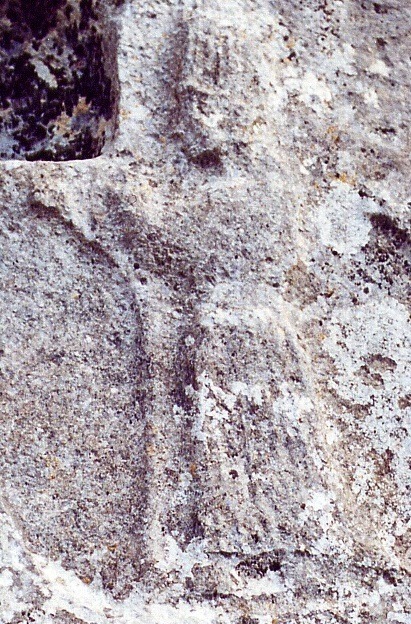
An indistinct Hurro-Hittite depiction of Ishara from the Yazilikaya sanctuary (wikimedia commons)
In love incantations, Nanaya belonged to an informal group which also included Inanna, Ishara, Kanisurra and Gazbaba. I do not think Inanna’s presence needs to be explained. Ishara had an independent connection with Inanna and was a multi-purpose deity to put it very lightly; in the realm of love she was particularly strongly connected with weddings and wedding nights. Kanisurra and Gazbaba warrant a bit more discussion, because they are arguably Nanaya’s supporting cast first and foremost. Gazbaba is, at the core, seemingly simply the personification of kuzbu. Her name had pretty inconsistent orthography, and variants such as Kazba or Gazbaya can be found in primary sources too. The last of them pretty clearly reflects an attempt at making her name resemble Nanaya’s. Not much can be said about her individual character beyond the fact she was doubtlessly related to love and/or sex. She is described as the “grinning one” in an incantation which might be a sexual allusion too, seeing as such expressions are a mainstay of Akkadian erotic poetry. Kanisurra would probably win the award for the fakest sounding Mesopotamian goddess, if such a competition existed. Her name most likely originated as a designation of the gate of the underworld, ganzer. Her default epithet was “lady of the witches” (bēlet kaššāpāti). And on top of that, like Nanaya and Gazbaba she was associated with sex. She certainly sounds more like a contemporary edgy oc of the Enoby Dimentia Raven Way variety than a bronze age goddess - and yet, she is completely genuine. It is commonly argued Kanisurra and Gazbaba were regarded as Nanaya’s daughters, but there is actually no direct evidence for this. In the only text where their relation to Nanaya is clearly defined they are described as her hairdressers, rather than children. While in some cases the love goddesses appear in love incantations in company of each other almost as if they were some sort of disastrous polycule, occasionally Nanaya is accompanied in them by an anonymous spouse. Together they occur in parallel with Inanna and Dumuzi and Ishara and Almanu, apparently a (accidental?) deification of a term referring to someone without family obligations. There is only one Old Babylonian source which actually assigns a specific identity to Nanaya’s spouse, a hymn dedicated to king Abi-eshuh of Babylon. An otherwise largely unknown god Muati (I patched up his wiki article just for the sake of this blog post) plays this role here. The text presents a curious case of reversal of gender roles: Muati is asked to intercede with Nanaya on behalf of petitioners. Usually this was the role of the wife - the best known case is Aya, the wife of Shamash, who is implored to do just that by Ninsun in the standard edition of the Epic of Gilgamesh. It’s also attested for goddesses such as Laz, Shala, Ninegal or Ninmug… and in the case of Inanna, for Ninshubur.
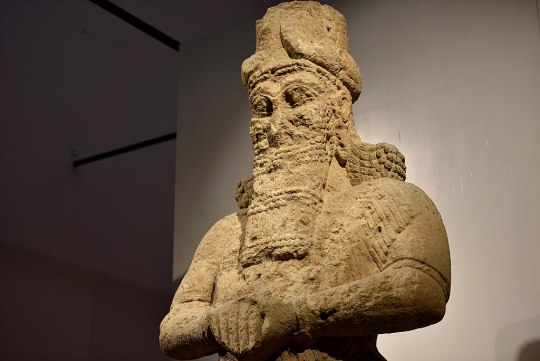
A Neo-Assyrian statue of Nabu on display in the Iraq Museum (wikimedia commons)
Marten Stol seems to treat Muati and Nabu as virtually the same deity, and on this basis states that Nanaya was already associated with the latter in the Old Babylonian period, but this seems to be a minority position. Other authors pretty consistently assume that Muati was a distinct deity at some point “absorbed” by Nabu. The oldest example of pairing Nanaya with Nabu I am aware of is an inscription dated to the reign of Marduk-apla-iddina I, so roughly to the first half of the twelfth century BCE. The rise of this tradition in the first millennium BCE was less theological and more political. With Babylon once again emerging as a preeminent power, local theologies were supposed to be subordinated to the one followed in the dominant city. Which, at the time, was focused on Nabu, Marduk and Zarpanit. Worth noting that Nabu also had a spouse before, Tashmetum (“reconciliation”). In the long run she was more or less ousted by Nanaya from some locations, though she retained popularity in the north, in Assyria. She is not exactly the most thrilling deity to discuss. I will confess I do not find the developments tied to Nanaya and Nabu to be particularly interesting to cover, but in the long run they might have resulted in Nanaya acquiring probably the single most interesting “supporting cast member” she did not share with Inanna, so we’ll come back to this later. Save for Bizilla, Nanaya generally was not provided with “equivalents” in god lists. I am only aware of one exception, and it’s a very recent discovery. Last year the first ever Akkadian-Amorite bilingual lists were published. This is obviously a breakthrough discovery, as before Amorite was largely known just from personal names despite being a vernacular language over much of the region in the bronze age, but only one line is ultimately of note here. In a section of one of the lists dealing with deities, Nanaya’s Amorite counterpart is said to be Pidray. This goddess is otherwise almost exclusively known from Ugarit. This of course fits very well with the new evidence: recent research generally stresses that Ugarit was quintessentially an Amorite city (the ruling house even claimed descent from mythical Ditanu, who is best known from the grandiose fictional genealogies of Shamshi-Adad I and the First Dynasty of Babylon). Sadly, we do not know how the inhabitants of Ugarit viewed Nanaya. A trilingual version of the Weidner list, with the original version furnished with columns listing Ugaritic and Hurrian counterparts of each deity, was in circulation, but the available copies are too heavily damaged to restore it fully. And to make things worse, much of it seems to boil down to scribal wordplay and there is no guarantee all of the correspondences are motivated theologically. For instance, the minor Mesopotamian goddess Imzuanna is presented as the counterpart of Ugaritic weather god Baal because her name contains a sign used as a shortened logographic writing of the latter. An even funnier case is the awkward attempt at making it clear the Ugaritic sun deity Shapash, who was female, is not a lesbian… by making Aya male. Just astonishing, really.
The worship of Nanaya
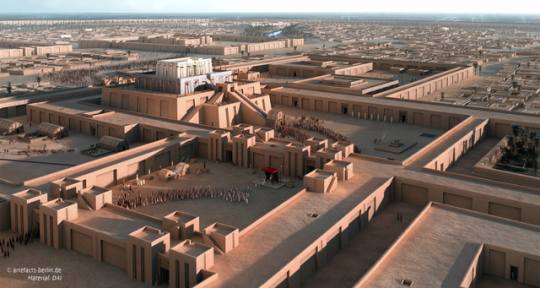
A speculative reconstruction of Ur III Uruk with the Eanna temple visible in the center (Artefacts — Scientific Illustration & Archaeological Reconstruction; reproduced here for educational purposes only, as permitted)
Rather fittingly, as a deity associated with Inanna, Nanaya was worshiped chiefly in Uruk. She is also reasonably well attested in the inscriptions of the short-lived local dynasty which regained independence near the end of the period of domination of Larsa over Lower Mesopotamia. A priest named after her, a certain Iddin-Nanaya, for a time served as the administrator of her temple, the Enmeurur, “house which gathers all the me,” me being a difficult to translate term, something like “divine powers”. The acquisition of new me is a common topic in Mesopotamian literature, and in compositions focused on Inanna in particular, so it should not be surprising to anyone that her peculiar double seemingly had similar interests. In addition to Uruk, as well as Nippur and Ur, after the Ur III period Nanaya spread to multiple other cities, including Isin, Mari, Babylon and Kish. However, she is probably by far the best attested in Larsa, where she rose to the rank of one of the main deities, next to Utu, Inanna, Ishkur and Nergal. She had her own temple, the Eshahulla, “house of a happy heart”. In local tradition Inanna got to keep her role as an “universal” major goddess and her military prerogatives, but Nanaya overtook the role of a goddess of love almost fully. Inanna’s astral aspect was also locally downplayed, since Venus was instead represented in the local pantheon by closely associated, but firmly distinct, Ninsianna. This deity warrants some more discussion in the future just due to having a solid claim to being one of the first genderfluid literary figures in history, but due to space constraints this cannot be covered in detail here. A later inscription from the same city differentiates between Nanaya and Inanna by giving them different epithets: Nanaya is the “queen of Uruk and Eanna” (effectively usurping Nanaya’s role) while Inanna is the “queen of Nippur” (that’s actually a well documented hypostasis of her, not to be confused with the unrelated “lady of Nippur”). Uruk was temporarily abandoned in the late Old Babylonian period, but that did not end Nanaya’s career. Like Inanna, she came to be temporarily relocated to Kish. It has been suggested that a reference to her residence in “Kiššina” in a Hurro-Hittite literary text, the Tale of Appu, reflects her temporary stay there. The next centuries of Nanaya are difficult to reconstruct due to scarce evidence, but it is clear she continued to be worshiped in Uruk. By the Neo-Babylonian period she was recognized as a member of an informal pentad of the main deities of the city, next to Inanna, Urkayitu, Usur-amassu and Beltu-sa-Resh. Two of them warrant no further discussion: Urkayitu was most likely a personification of the city, and Beltu-sa-Resh despite her position is still a mystery to researchers. Usur-amassu, on the contrary, is herself a fascinating topic. First attestations of this deity, who was seemingly associated with law and justice (a pretty standard concern), come back to the Old Babylonian period. At this point, Usur-amassu was clearly male, which is reflected by the name. He appears in the god list An = Anum as a son of the weather deity couple par excellence, Adad (Ishkur) and Shala. However, by the early first millennium BCE Usur-amassu instead came to be regarded as female - without losing the connection to her parents. She did however gain a connection to Inanna, Nanaya and Kanisurra, which she lacked earlier. How come remains unknown. Most curiously her name was not modified to reflect her new gender, though she could be provided with a determinative indicating it. This recalls the case of Lagamal in the kingdom of Mari some 800 years earlier.
The end of the beginning: Nanaya under Achaemenids and Seleucids
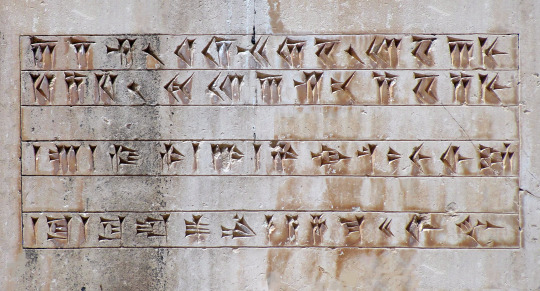
Trilingual (Persian, Elamite and Akkadian) inscription of the first Achamenid ruler of Mesopotamia, Cyrus (wikimedia commons)
After the fall of the Neo-Babylonian Empire Mesopotamia ended up under Achaemenid control, which in turn was replaced by the Seleucids. Nanaya flourished through both of these periods. In particular, she attained considerable popularity among Arameans. While they almost definitely first encountered her in Uruk, she quickly came to be venerated by them in many distant locations, like Palmyra, Hatra and Dura Europos in Syria. She even appears in a single Achaemenid Aramaic papyrus discovered in Elephantine in Egypt. It indicates that she was worshiped there by a community which originated in Rash, an area east to the Tigris. As a curiosity it’s worth mentioning the same source is one of the only attestations of Pidray from outside Ugarit. I do not think this has anything to do with the recently discovered connection between her and Nanaya… but you may never know. Under the Seleucids, Nanaya went through a particularly puzzling process of partial syncretism. Through interpretatio graeca she was identified with… Artemis. How did this work? The key to understanding this is the fact Seleucids actually had a somewhat limited interest in local deities. All that was necessary was to find relatively major members of the local pantheon who could roughly correspond to the tutelary deities of their dynasty: Zeus, Apollo and Artemis. Zeus found an obvious counterpart in Marduk (even though Marduk was hardly a weather god). Since Nabu was Marduk’s son, he got to be Apollo. And since Nanaya was the most major goddess connected to Nabu, she got to be Artemis. It really doesn’t go deeper than that. For what it’s worth, despite the clear difference in character this newfound association did impact Nanaya in at least one way: she started to be depicted with attributes borrowed from Artemis, namely a bow and a crescent. Or perhaps these attributes were already associated with her, but came to the forefront because of the new role. The Artemis-like image of Nanaya as an archer is attested on coins, especially in Susa, yet another city where she attained considerable popularity.
Leaving Mesopotamia: Nanaya and the death of cuneiform
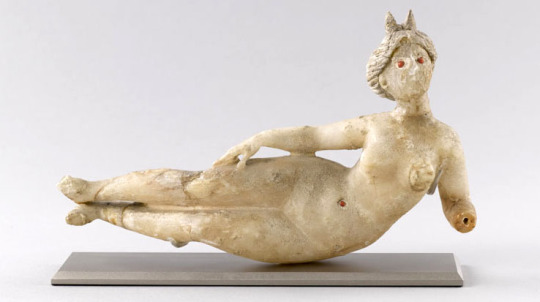
A Parthian statue of Nanaya with a crescent diadem (Louvre; reproduced here for educational purposes only. Identification follows Andrea Sinclair's proposal)
The Seleucid dynasty was eventually replaced by the Parthians. This period is often considered a symbolic end of ancient Mesopotamian religion in the strict sense. Traditional religious institutions were already slowly collapsing in Achaemenid and Seleucid times as the new dynasties had limited interest in royal patronage. Additionally, cuneiform fell out of use, and by the end of the first half of the first millennium CE the art of reading and writing it was entirely lost. This process did not happen equally quickly everywhere, obviously, and some deities fared better than others in the transitional period before the rise of Christianity and Islam as the dominant religions across the region. Nanaya was definitely one of them, at least for a time. In Parthian art Nanaya might have developed a distinct iconography: it has been argued she was portrayed as a nude figure wearing only some jewelry (including what appears to be a navel piercing and a diadem with a crescent. The best known example is probably this standing figure, one of my all time favorite works of Mesopotamian art:

Parthian Nanaya (wikimedia commons; identification courtesy of the Louvre website and J. G. Westenholz)
For years Wikipedia had this statue mislabeled as “Astarte” which makes little sense considering it comes from a necropolis near Babylon. There was also a viral horny tweet which labeled it as “Asherah” a few months ago (I won’t link it but I will point out in addition to getting the name wrong op also severely underestimated the size). This is obviously even worse nonsense both on spatial and temporal grounds. Even if the biblical Asherah was ever an actual deity like Ugaritic Athirat and Mesopotamian Ashratum, it is highly dubious she would still be worshiped by the time this statue was made. It’s not even certain she ever was a deity, though. Cognate of a theonym is not automatically a theonym itself, and the Ugaritic texts and the Bible, even if they share some topoi, are separated by centuries and a considerable distance. This is not an Asherah post though, so if this is a topic which interests you I recommend downloading Steve A. Wiggins’ excellent monograph A Reassessment of Asherah: With Further Considerations of the Goddess.
The last evidence for the worship of Nanaya in Mesopotamia is a Mandaean spell from Nippur, dated to the fifth or sixth century CE. However, at this point Nanaya must have been a very faint memory around these parts, since the figure designated by this name is evidently male in this formula. That was not the end of her career, though. The system of beliefs she originated and thrived in was on its way out, but there were new frontiers to explore. A small disgression is in order here: be INCREDIBLY wary of claims about the survival of Mesopotamian tradition in Mesopotamia itself past the early middle ages. Most if not all of these come from the writing of Simo Parpola, who is a 19th century style hyperdiffusionist driven by personal religious beliefs based on gnostic christianity, which he believes was based on Neo-Assyrian state religion, which he misinterprets as monotheism, or rather proto-christianity specifically (I wish I was making this up). I personally do not think a person like that should be tolerated in serious academia, but for some incomprehensible reason that isn’t the case.
New frontiers: Nanaya in Bactria
The key to Nanaya’s extraordinarily long survival wasn’t the dedication to her in Mesopotamia, surprisingly. It was instead her introduction to Bactria, a historical area in Central Asia roughly corresponding to parts of modern Afghanistan, Tajikistan and Uzbekistan. The early history of this area is still poorly known, though it is known that it was one of the “cradles of civilization” not unlike Mesopotamia, the Indus Valley or Mesoamerica. The so-called “Oxus civilization” or “Bactria-Margiana Archaeological Complex” flourished around 2500-1950 BCE (so roughly contemporarily with the Akkadian and Ur III empires in Mesopotamia). It left behind no written records, but their art and architecture are highly distinctive and reflect great social complexity. I sadly can’t spent much time discussing them here though, as they are completely irrelevant to the history of Nanaya (there is a theory that she was already introduced to the east when BMAC was extant but it is incredibly implausible), so I will limit myself to showing you my favorite related work of art, the “Bactrian princess”:
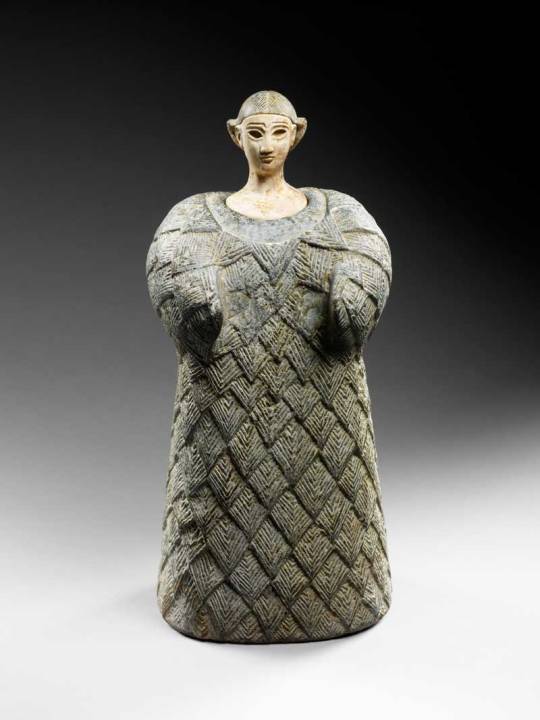
Photo courtesy of Louvre Abu Dhabi, reproduced here for educational purposes only.
By late antiquity, which is the period we are concerned with here, BMAC was long gone, and most of the inhabitants of Bactria spoke Bactrian, an extinct Iranian language. How exactly they were related to their BMAC forerunners is uncertain. Their religious beliefs can be compared to Zoroastrianism, or rather with its less formalized forerunners followed by most speakers of Iranian languages before the rise of Zoroaster. However, there were many local peculiarities. For example, the main deity was the personified river Oxus, not Ahura Mazda. Whether this was a relic of BMAC religion is impossible to tell.We do not know exactly when the eastward transfer of Nanaya to Bactria happened. The first clear evidence for her presence in central Asia comes from the late first century BCE, from the coins of local rulers, Sapadbizes and Agesiles. It is possible that her depictions on coinage of Mesopotamian and Persian rulers facilitated her spread. Of course, it’s also important to remember that the Aramaic script and language spread far to the east in the Achaemenid period already, and that many of the now extinct Central Asian scripts were derived from it (Bactrian was written with the Greek script, though). Doubtlessly many now lost Aramaic texts were transferred to the east. There’s an emerging view that for unclear reasons, under the Achaemenids Mesopotamian culture as a whole had unparalleled impact on Bactria. The key piece of evidence are Bactrian temples, which often resemble Mesopotamian ones. Therefore, perhaps we should be wondering not why Nanaya spread from Mesopotamia to Central Asia, but rather why there were no other deities who did, for the most part. That is sadly a question I cannot answer. Something about Nanaya simply made her uniquely appealing to many groups at once. While much about the early history of Nanaya in Central Asia is a mystery, it is evident that with time she ceased to be viewed as a foreign deity. For the inhabitants of Bactria she wasn’t any less “authentically Iranian” than the personified Oxus or their versions of the conventional yazatas like Sraosha. Frequently arguments are made that Nanaya’s widespread adoption and popularity could only be the result of identification between her and another deity.Anahita in particular is commonly held to be a candidate. However, as stressed by recent studies there’s actually no evidence for this. What is true is that Anahita is notably missing from the eastern Iranian sources, despite being prominent in the west from the reign of the Achaemenid emperor Artaxerxes II onward. However, it is clear that not all yazatas were equally popular in each area - pantheons will inevitably be localized in each culture. Furthermore, Anahita’s character has very little in common with Nanaya save for gender. Whether we are discussing her early not quite Zoroastrian form the Achaemenid public was familiar with or the contemporary yazata still relevant in modern Zoroastrianism, the connection to water is the most important feature of her. Nanaya didn’t have such a role in any culture. Recently some authors suggested a much more obvious explanation for Anahita’s absence from the eastern Iranian pantheon(s). As I said, eastern Iranian communities venerated the river Oxus as a deity (or as a yazata, if you will). He was the water god par excellence, and in Bactria also the king of the gods. It is therefore quite possible that Anahita, despite royal backing from the west, simply couldn’t compete with him. Their roles overlapped more than the roles of Anahita and Nanaya. I am repeating myself but the notion of interchangeability of goddesses really needs to be distrusted almost automatically, no matter how entrenched it wouldn’t be. While we’re at it, the notion of alleged interchangeability between Anahita and Ishtar is also highly dubious, but that’s a topic for another time.
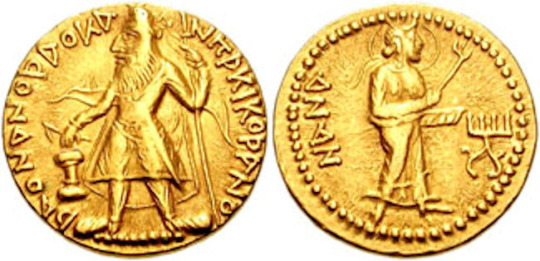
Nana (Nanaya) on a coin of Kanishka (wikimedia commons)
Nanaya experienced a period of almost unparalleled prosperity with the rise of the Kushan dynasty in Bactria. The Kushans were one of the groups which following Chinese sources are referred to as Yuezhi. They probably did not speak any Iranian language originally, and their origin is a matter of debate. However, they came to rule over a kingdom which consisted largely of areas inhabited by speakers of various Iranian languages, chiefly Bactrian. Their pantheon, documented in royal inscriptions and on coinage, was an eerie combination of mainstays of Iranian beliefs like Sraosha and Mithra and some unique figures, like Oesho, who was seemingly the reflection of Hindu Shiva. Obviously, Nanaya was there too, typically under the shortened name Nana. The most famous Kushan ruler, emperor Kanishka, in his inscription from Rabatak states that kingship was bestowed upon him by “Nana and all the gods”. However, we do not know if the rank assigned to her indicates she was the head of the dynastic pantheon, the local pantheon in the surrounding area, or if she was just the favorite deity of Kanishka. Same goes for the rank of numerous other deities mentioned in the rest of the inscription. Her apparent popularity during Kanishka’s reign and beyond indicates her role should not be downplayed, though. The coins of Kanishka and other Bactrian art indicate that a new image of Nanaya developed in Central Asia. The Artemis-like portrayals typical for Hellenistic times continue to appear, but she also started to be depicted on the back of a lion. There is only one possible example of such an image from the west, a fragmentary relief from Susa, and it’s roughly contemporary with the depictions from Bactria. While it is not impossible Nanaya originally adopted the lion association from one of her Mesopotamian peers, it is not certain how exactly this specific type of depictions originally developed, and there is a case to be made that it owed more to the Hellenistic diffusion of iconography of deities such as Cybele and Dionysus, who were often depicted riding on the back of large felines. The lunar symbols are well attested in the Kushan art of Nanaya too. Most commonly, she’s depicted wearing a diadem with a crescent. However, in a single case the symbol is placed behind her back. This is an iconographic type which was mostly associated with Selene at first, but in the east it was adopted for Mah, the Iranian personification of the moon. I’d hazard a guess that’s where Nanaya borrowed it from - more on that later. The worship of Nanaya survived the fall of the Kushan dynasty, and might have continued in Bactria as late as in the eighth century. However, the evidence is relatively scarce, especially compared with yet another area where she was introduced in the meanwhile.
Nanaya in Sogdia: new home and new friends
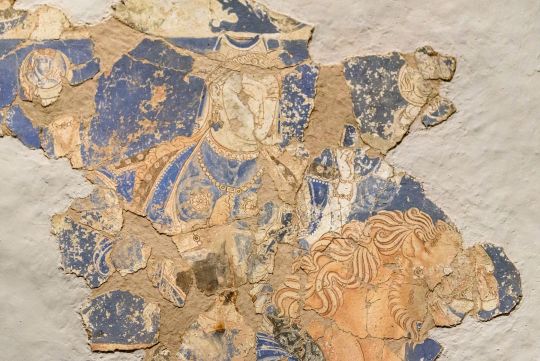
A Sogdian depiction of Nanaya from Bunjikat (wikimedia commons)
Presumably from Bactria, Nanaya was eventually introduced to Sogdia, its northern neighbor. I think it’s safe to say this area effectively became her new home for the rest of her history. Like Bactrians, the Sogdians also spoke an eastern Iranian language, Sogdian. It has a direct modern descendant, Yaghnobi, spoken by a small minority in Tajikistan. The religions Sogdians adhered to is often described as a form of Zoroastrianism, especially in older sources, but it would appear that Ahura Mazda was not exactly the most popular deity. Their pantheon was seemingly actually headed by Nanaya. Or, at the very least, the version of it typical for Samarkand and Panijkant, since there’s a solid case to be made for local variety in the individual city-states which made up Sogdia. It seems that much like Mesopotamians and Greeks centuries before them, Sogdians associated specific deities with specific cities, and not every settlement necessarily venerated each deity equally (or at all). Nanaya's remarkable popularity is reflected by the fact the name Nanaivandak, "servant of Nanaya", is one of the most common Sogdian names in general. It is agreed that among the Sogdians Panjikant was regarded as Nanaya’s cult center. She was referred to as “lady” of this city. At one point, her temple located there was responsible for minting the local currency. By the eighth century, coins minted there were adorned with dedications to her - something unparalleled in Sogdian culture, as the rest of coinage was firmly secular. This might have been an attempt at reasserting Sogdian religious identity in the wake of the arrival of Islam in Central Asia. Sogdians adopted the Kushan iconography of Nanaya, though only the lion-mounted version. The connection between her and this animal was incredibly strong in Sogdian art, with no other deity being portrayed on a similar mount. There were also innovations - Nanaya came to be frequently portrayed with four arms. This reflects the spread of Buddhism through central Asia, which brought new artistic conventions from India. While the crescent symbol can still be found on her headwear, she was also portrayed holding representations of the moon and the sun in two of her hands. Sometimes the solar disc and lunar orb are decorated with faces, which has been argued to be evidence that Nanaya effectively took over the domains of Mah and Mithra, who would be the expected divine identities of these two astral bodies. She might have been understood as controlling the passage of night and day. It has also been pointed out that this new iconographic type is the natural end point of the evolution of her astral role. Curiously, while no such a function is attested for Nanaya in Bactria, in Sogdia she could be sometimes regarded as a warlike deity. This is presumably reflected in a painting showing her and an unidentified charioteer fighting demons.
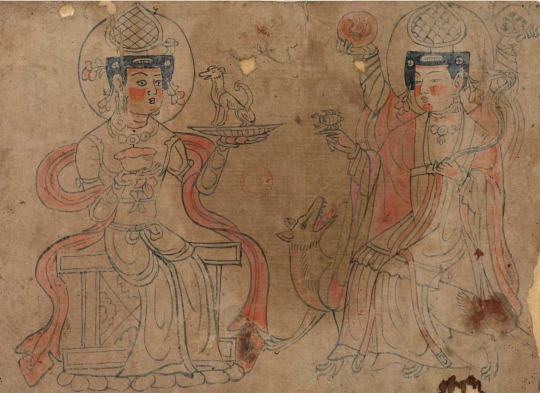
The "Sogdian Deities" painting from Dunhuang, a possible depiction of Nanaya and her presumed spouse Tish (wikimedia commons)
Probably the most fascinating development regarding Nanaya in Sogdia was the development of an apparent connection between her and Tish. This deity was the Sogdian counterpart of one of the best known Zoroastrian yazatas, Tishtrya, the personification of Sirius. As described in the Tištar Yašt, the latter is a rainmaking figure and a warlike protector who keeps various nefarious forces, such as Apaosha, Duzyariya and the malign “worm stars” (comets), at bay. Presumably his Sogdian counterpart had a similar role. While this is not absolutely certain, it is generally agreed that Nanaya and Tish were regarded as a couple in central Asia (there’s a minority position she was instead linked with Oesho, though). Most likely the fact that in Achaemenid Persia Tishtrya was linked with Nabu (and by extension with scribal arts) has something to do with this. There is a twist to this, though. While both Nabu and the Avestan Tishtrya are consistently male, in Bactria and Sogdia the corresponding deity’s gender actually shows a degree of ambiguity. On a unique coin of Kanishka, Tish is already portrayed as a feminine figure distinctly similar to Greek Artemis - an iconographic type which normally would be recycled for Nanaya. There’s also a possibility that a feminine, or at least crossdressing, version of Tish is portrayed alongside Nanaya on a painting from Dunhuang conventionally referred to as “Sogdian Daēnās” or “Sogdian Deities”, but this remains uncertain. If this identification is correct, it indicates outright interchange of attributes between them and Nanaya was possible.
The final frontier: Nanaya and the Sogdian diaspora in China Sogdians also brought Nanaya with them to China, where many of them settled in the Six Dynasties and Tang periods. An obviously Sinicized version of her, accompanied by two attendants of unknown identity, is portrayed on a Sogdian funerary couch presently displayed in the Miho Museum.
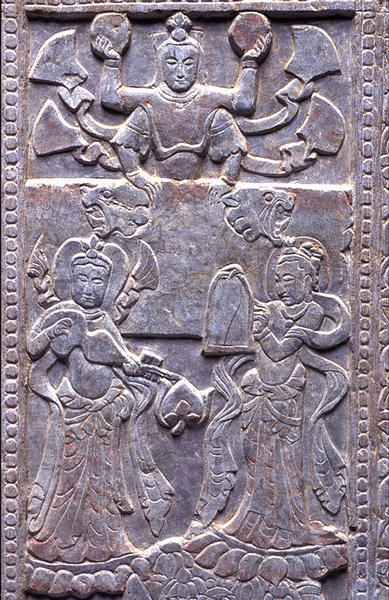
Nanaya (top) on a relief from the Miho funerary couch (Miho Museum; reproduced here for educational purposes only)
For the most part the evidence is limited to theophoric names, though. Due to unfamiliarity with Sogdian religious traditions and phonetic differences between the languages there was no consistent Chinese transcription of Nanaya’s name. I have no clue if Chinese contemporaries of the Sogdians were always aware of these elements in personal names referred to a deity. There is a fringe theory that Nanaya was referred to as Nantaihou (那那女主, “queen Nana”) in Chinese. However, the evidence is apparently not compelling, and as I understand the theory depends in no small part on the assertion that a hitherto unattested alternate reading of one of the signs was in use on the western frontiers of China in the early first millennium CE. The alleged Nantaihou is therefore most likely a misreading of a reference to a deceased unnamed empress dowager venerated through conventional ancestor worship, as opposed to Nanaya. Among members of the Sogdian diaspora, in terms of popularity Nanaya was going head to head with Jesus and Buddha. The presence of the latter two reflected the adoption of, respectively, Manichaeism and Buddhism. Manicheans seemingly were not fond of Nanaya, though, and fragments of a polemic against her cult have been identified. It seems ceremonies focused on lamentations were the main issue for the Manichaeans. Sadly there doesn’t seem to be any worthwhile study of possible Mesopotamian influence on that - the only one I found is old and confuses Nanaya with Inanna. We do not have much of an idea how Buddhists viewed Nanaya, though it is worth noting a number of other Sogdian deities were incorporated into the local form of Mahayana (unexpectedly, one of them was Zurvan). It has also been argued that a Buddhist figure, Vreshman (Vaisravana) was incorporated into Nanaya’s entourage. Nanaya might additionally be depicted in a painting showing Buddha’s triumph over Mara from Dunhuang. Presumably her inclusion would reflect the well attested motif of local deities converting to Buddhism. It was a part of the Buddhist repertoire from the early days of this religion and can be found in virtually every area where this religion ever spread. Nanaya is once again in elevated company here, since other figures near her have been tentatively interpreted as Shiva, Vishnu, Kartikeya and… Zoroaster.

Buddha conquering Mara (maravijaya) on a painting from Dunhuang (wikimedia commons)

zoom in on a possible depiction of Nanaya next to a demon suspiciously similar to Tove Jansson’s Fillyjonk
To my best knowledge, the last absolutely certain attestation of Nanaya as an actively worshiped deity also comes from the western frontier of China. A painting from Dandan Oilik belonging to the artistic tradition of the kingdom of Khotan shows three deities from the Sogdian pantheon: the enigmatic Āδβāγ (“highest god”; interpreted as either Indra, Ahura Mazda or a combination of them both) on the left, Weshparkar (a later version of Kushan Oesho) on the right and Nanaya in the center. It dates to the ninth or tenth century.
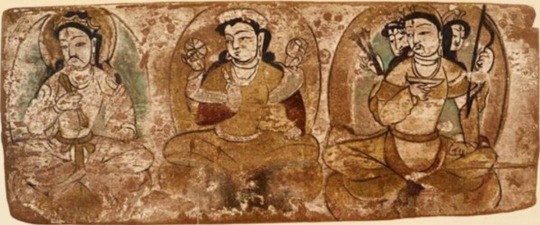
Nanaya (center) on the Dandan Oilik painting (wikimedia commons)
We will probably never know what Nanaya’s last days were like, though it is hard to imagine she retained much relevance with the gradual disappearance of Sogdian culture both in Sogdia and in China in the wake of, respectively, the rise of Islam in Central Asia and the An Lushan rebellion respectively. Her history ultimately most likely ended with a whimper rather than a bang. Conclusions and reflections Obviously, not everything about Nanaya could be covered in this article - there is enough material to warrant not one, but two wiki articles (and I don't even think they are extensive enough yet). I hope I did nonetheless manage to convey what matters: she was the single most enduring Mesopotamian deity who continued to be actually worshiped. She somehow outlived Enlil, Marduk, Nergal and even Inanna, and spread further than any of them ever did. It does not seem like her persistence was caused by some uniquely transcendent quality, and more to a mix of factors we will never really fully understand and pure luck. She is a far cry from the imaginary everlasting universal goddesses such longevity was attributed to by many highly questionable authors in the past, from Frazer to Gimbutas. Quite the opposite, once you look into the texts focused on her she comes across as sort of pathetic. After all, most of them are effectively ancient purple prose. And yet, this is precisely why I think Nanaya matters. To see how an author approaches her is basically a litmus test of trustworthiness - I wish I was kidding but this “Nanaya method” works every time. To even be able to study her history, let alone understand it properly, one has to cast away most of the dreadful trends which often hindered scholarship of ancient deities, and goddesses in particular, in the past. The interchangeability of goddesses; the Victorian mores and resulting notion that eroticism must be tied to fertility; the weird paradigms about languages neatly corresponding to religions; and many others. And if nothing else, this warrants keeping the memory of her 3000 years long history alive through scholarship (and, perhaps, some media appearances). Bibliography
Julia M. Asher-Greve & Joan Goodnick Westenholz, Goddesses in Context: On Divine Powers, Roles, Relationships and Gender in Mesopotamian Textual and Visual Sources (2013)
Paul-Alain Beaulieu, The Pantheon of Uruk During the Neo-Babylonian Period (2003)
idem, Nabû and Apollo: The Two Faces of Seleucid Religious Policy in: Orient und Okzident in Hellenistischer Zeit (2014)
Matteo Compareti, Nana and Tish in Sogdiana (2017)
idem, The So-Called "Pelliot Chinois 4518.24". Illustrated Document from Dunhuang and Sino-Sogdian Iconographical Contacts (2021)
Olga Drewnowska-Rymarz, Mesopotamian Goddess Nanāja (2008)
Benjamin R. Foster, Before the Muses: an Anthology of Akkadian Literature (2005)
Andrew R. George & Manfred Krebernik, Two Remarkable Vocabularies: Amorite-Akkadian Bilinguals! (2022)
Valerie Hansen, Kageyama Etsuko & Yutaka Yoshida, The Impact of the Silk Road Trade on a Local Community: The Turfan Oasis, 500-800 in: Les sogdiens en Chine (2005)
Wilfred G. Lambert, Babylonian Creation Myths (2013)
Enrico Marcato, An Aramaic Incantation Bowl and the Fall of Hatra (2020)
Christa Müller-Kessler & Karlheinz Kessler, Spätbabylonische Gottheiten in spätantiken mandäischen Texten (1999)
Lilla Russel-Smith, Uygur Patronage in Dunhuang. Regional Art Centres on the Northern Silk Road in the Tenth and Eleventh Centuries (2005)
idem, The 'Sogdian Deities' Twenty Years on: A Reconsideration of a Small Painting from Dunhuang in: Buddhism in Central Asia II. Practices and Rituals, Visual and Material Transfer (2022)
Tonia M. Sharlach, An Ox of One's Own. Royal Wives and Religion at the Court of the Third Dynasty of Ur (2017)
Michael Shenkar, Intangible Spirits and Graven Images: The Iconography of Deities in the Pre-Islamic Iranian World (2014)
idem, The Religion and the Pantheon of the Sogdians (5th-8th Centuries CE) in Light of their Sociopolitical Structures (2017)
idem, The So-Called "Fravašis" and the "Heaven and Hell" Paintings, and the Cult of Nana in Panjikent (2022)
Marten Stol, Nanaja in: Reallexikon der Assyriologie, vol. 9 (1998)
Michael P. Streck & Nathan Wasserman, More Light on Nanāya (2013)
Aaron Tugendhaft, Gods on Clay: Ancient Near Eastern Scholarly Practices and the History of Religions in: Canonical Texts and Scholarly Practices. A Global Comparative Approach (2016)
Joan Goodnick Westenholz, Nanaya, Lady of Mystery in: Sumerian Gods and Their Representations (1997)
idem, Trading the Symbols of the Goddess Nanaya in: Religions and Trade. Religious Formation, Transformation and Cross-Cultural Exchange between East and West (2014)
Xinjiang Rong, The Colophon of the Manuscript of the Golden Light Sutra Excavated in Turfan and the Transmission of Zoroastrianism to Gaochang in: The Silk Road and Cultural Exchanges between East and West (2022)
Gioele Zisa, The Loss of Male Sexual Desire in Ancient Mesopotamia. ›Nīš Libbi‹ Therapies (2021)
#mesopotamian mythology#sumerian mythology#mythology#bactrian mythology#sogdian mythology#sogdia#nanaya
512 notes
·
View notes
Text
so since attested akkadian texts span a period of almost three millenia (!), there's naturally quite a bit of dialectical variation both geographically ("assyrian" in the north, "babylonian" in the south), and diachronically (e.g., "old," "middle," and "late" babylonian)
but my favorite detail so far, per huehnergard:
Already during the Kassite period [when Middle Babylonian was spoken] Old Babylonian had come to be regarded as the classical period of Akkadian language and literature, and scribes in both Babylonia and Assyria attempted to duplicate it in a purely literary (i.e., unspoken) dialect that Assyriologists call Standard Babylonian (SB). The scribes' efforts to reproduce the classical language usually had mixed results, as their own language patterns frequently intruded. Standard Babylonian is the dialect in which such important works as Enūma eliš and the later, longer version of Gilgamesh are written, indeed, all of the literary texts of the late second and the first millenia, as well as many royal inscriptions.
badly aping archaic language to tell your myths is apparently about as old as mythology itself
85 notes
·
View notes
Text

Babylonian Map of the World, 8th or 7th Century B.C.
The Babylonian Map of the World (also Imago Mundi or Mappa mundi) is a Babylonian clay tablet with a schematic world map and two inscriptions written in the Akkadian language. It includes a brief and partially lost textual description.
The tablet describes the oldest known depiction of the known world. Ever since its discovery there has been controversy on its general interpretation and specific features. Another pictorial fragment, VAT 12772, presents a similar topography from roughly two millennia earlier.
The map is centered on the Euphrates, flowing from the north (top) to the south (bottom), with its mouth labelled "swamp" and "outflow". The city of Babylon is shown on the Euphrates, in the northern half of the map. Susa, the capital of Elam, is shown to the south, Urartu to the northeast, and Habban, the capital of the Kassites, is shown (incorrectly) to the northwest. Mesopotamia is surrounded by a circular "bitter river" or Ocean, and seven or eight foreign regions are depicted as triangular sections beyond the Ocean, perhaps imagined as mountains.
The tablet was excavated by Hormuzd Rassam at Sippar, Baghdad vilayet, some 60 km north of Babylon on the east bank of the Euphrates River. It was acquired by the British Museum in 1882 (BM 92687); the text was first translated in 1889. The tablet is usually thought to have originated in Borsippa. In 1995, a new section of the tablet was discovered, at the point of the upper-most triangle.
Clay, Height: 12.2 cm (4.8 in), Width: 8.2 cm (3.2 in)
Courtesy: British Museum
#art#history#design#style#archeology#sculpture#antiquity#tablet#map#map of the world#babylon#british museum#mesopotamia#text#writing#drawing#euphrates#elam#susa#habban
128 notes
·
View notes
Text
Conceptualising 10,000 Years
Yes, this is another post about how the ten-thousand-year-old primordial saints of the Resurrection are, indeed, very old. But the tricky thing about human minds is that they're really bad at comprehending massive numbers. So, in this post, I hope to give you, my dear reader, an understanding of what it means to be ten thousand years old.
Let us imagine, just for a moment, that today (28 August, 2024) marks the close of the myriadic year of our Lord–that far-off King of Necromancers, that blessed Resurrector of Saints!–and the Lyctors reach ten thousand years old today. From this premise, I believe we can better grasp just how old these people are, since we can timeline their lives based on real-world events. So, without further ado...
8000 BCE - The Great Resurrection. Earth is still experiencing the last great Ice Age. Woolly mammoths are still thriving, and, according to some estimates, the last of the smilodon and American lion species still lives. HS Sapiens are still in the Stone Age. Earliest records of ovens used for pottery.
7700 BCE - Lyctors reach 300 years old. Farmers first domesticate wheat in the area now known as Mesopotamia. Humans have yet to develop advanced agricultural technology, instead relying on very primitive methods.
7000 BCE - Lyctors are now 1000 years old. Domestication of goats in Mesopotamia.
6700 BCE- Lyctors are 1300 years old. Domestication of pigs in Mesopotamia.
6200 BCE - Lyctors are 1800 years old. The Bronze Age begins! Earliest evidence of the smelting of bronze dates back to roughly 6200 BCE in Asia Minor. With the advent of bronze, humans are able to make more effective and more durable tools.
6000 BCE - Lyctors are 2000 years old. First settlements along the Nile River
5500 BCE - Lyctors are 2500 years old. Earliest evidence of Ancient Sumer.
5000 BCE - Lyctors are 3000 years old. Major agricultural developments occurred around this time, including the first evidence for the usage of irrigation.
4000 BCE -Lyctors are 4000 years old. Extinction of the Woolly Mammoth. Humans develop the first cities around this time, and wool is first used as in textiles.
3100 BCE - Lyctors are 4900 years old. Construction on Stonehenge begins. Recorded history emerges around this time. The rise of Ancient Egypt begins. Earliest cuneiform texts date back to this time.
2334 BCE - Lyctors are 5666 years old. Sargon of Akkad is King of the Akkadian Empire.
2154 BCE - Lyctors are 5846 years old. Akkadian empire dissolves after less than 200 years wow!
2000 BCE - Lyctors are 6000 years old. Ancient Minoan civilization begins.
1341 BCE - Lyctors are 6659 years old. Birth of King Tut.
1250 BCE - Lycors are 6750 years old. Ancient Chinese and Ancient Olmec civilization begins.
800 BCE - Lyctors are 7200 years old. Start of the Classical Period.
500 CE - Lyctors are 8500 years old. End of the Classical Period. Sorry, too lazy to write all of it out. Plus, there's a billion resources on it.
900 CE - Lyctors are 8900 years old. Start of the Dark Ages.
1492 CE - Lyctors are 9492 years old. Planning of Dios Apate Major begins around here in the Locked Tomb timeline. Columbus "discovers" the Americas (and proceeds to slaughter indigenous peoples)
2000 - The myriadic year of our lord.
I hope you understand how old these people are. DISCLAIMER: Not a historian. Do not claim to be. These dates are from cursory research and could be inaccurate. Furthermore, this is nowhere near a complete account of human history, especially towards the end, when I got really bored.
Ty <3
134 notes
·
View notes
Note
Heya! I'm looking at the famous Complaint Tablet to Ea-Nāṣir and I'm having difficulty with one part of the Akkadian. Specifically, lines 16 through 18: ya-ti a-na ki-ma ma-an-ni-im / tu-ši-im-ma ni-[x-x-x]-ma / ki-a-am te-me-ša-an-ni. I get that the first line is "me, like what sort of person" and the last line is "you treat me so badly", but I'm lost on the one in between. Is this a verb like "wašāmum" or something? And what might the damaged word be? Tyvm!
In my translation, I translated those lines loosely as "Are you really going to treat me this way, insulting me like that?" Here is the hand drawing of them:

Word-by-word, this is how I'd translate it:
iāti ana kīma mannim: "me, like what kind of thing..." tu-ši-im-ma-ni-[i]-ma: "... are you treating me?" kī'am tumêšanni: "how you despise me!"
CAD parses the middle line as a single verb, a shin-stem durative of the trebly weak verb ewû, plus a first-person suffix and the -ma coordinating conjunction, and I agree.
The tricky part is that the first half of that line is inscribed quite densely, so there's definitely space for more than an "i" in the missing area in the center, which is why your transcription has space for three signs there. But on the other hand, the "ma" has lots of space around it, so it's possible that the scribe began writing densely, then realized that they had lots of space, so they spaced out the "i-ma" signs at the end of the line. Since the text makes sense with the single sign, I'm inclined to stick with the CAD (and Leemans, whose transliteration agrees).
Let me know if you have follow-up questions!
75 notes
·
View notes
Note
“i love it theologically but in my personal religion idk how it makes me feel. this is actually a super common phenomenon - christian theologians are often very liberal in their theology and more conservative in their own religion.” Can you please please please talk more about this distinction????
Of COURSE! I’m still trying to find where I got this fact but I always have like 10 books on the go not including journal articles etc so I have a lot to dig through! So firstly, it’s quite an important distinction. There is a massive overlap between theology and religion, and exploring theology naturally impacts one’s own religious beliefs, and vice versa, therefore it’s not a hard line per say. However, it is crucial that theologians can have some separation. For example, one of the first questions they asked me in a certain unnamed university interview that you’re not meant to give any details about picked up on this. I was given a few passages taken from different religious traditions, and we discussed their similarities and differences. A little into the conversation, they told me that the passages had been written sequentially, with each a few hundred years after another, and asked “Could the later ones possibly have been inspired by the earlier one?” One of the later passages was taken from the New Testament, with this question carrying the suggestion that an author in the NT had been inspired by Ancient Greek mythology. If you’re answering that from a religious perspective, no, absolutely not! This is where they start to separate.
A good part of theology requires looking at religious texts as a piece of literature. In my Extended Essay for IB I wrote about Cozbi, and a significant chunk of my work looked at word choice in a variety of translations, including the original Hebrew. This meant looking at how she had been named (Cozbi was probably not her real name - it means ‘to lie’ and ‘lies’, and the Akkadian equivalent of her name, ‘kuzbu’, means ‘voluptuousness’, ‘sexually vigorous’, and is a euphemism for genitals) to convey a message, and the use of grammar and vocabulary in order to pin the blame on her as opposed to the Israelite man Zimri. So in this, I’m looking at the Bible as literature, and making arguments which are quite tricky to make from a Christian standpoint - to look at my religious text and say ‘The author of this text has chosen these words to manipulate the reader’, when in my Christian head, the author of the text is God (as discussed in earlier posts, expressed by humans). So, I think that interview question aimed to very quickly sort out those who are not able to have that distinction. That’s not necessarily a bad thing, but it would make it very difficult to study Theology, and be taught Theology, I think.
But this distinction is where the liberal theology vs conservative religion comes in. My argument in my Cozbi essay, that the Bible deliberately uses women as plot devices and scapegoats, is liberal, and, honestly, not something I really want to believe! And arguing something academically, especially in the field of Theology, doesn’t necessarily mean you have to believe it. If you’re arguing something in Chemistry, that’s a bit different! Do I think my Cozbi essay is academically compelling? Yes. I am academically persuaded by it. Do I believe it religiously? Do I think that’s what God’s word is really trying to say? No. Do I think my icons essay is academically compelling? Yes. Do I think it justifies the use of icons in the Church of England? Yes. Would I have icons without it? Also yes. Writing that essay, although informative, did not alter my personal religious beliefs.
I think there’s also this weird overlap in the Tumblr-Christian-Theology little niche that you and I like to sit in. You do it much better than me. Your theological arguments persuade me, and I do think I often believe them religiously. However, my theological arguments aren’t meant to do that. Mine are often purely academic. This also links back to a post you made a few months ago that I wanted to talk about but didn’t have the words for. You talked about not liking people distinguishing between ‘theologies’ ie ‘feminist theology’ ‘liberation theology’ etc etc. And I agree and disagree, once more based on this distinction. If ‘theology’ is your personal theology, what you believe about God and religion, then yes, this idea of ‘feminist theology’ is really weird. However, when I say I’m a ‘feminist theologian’ or I’m interested in ‘liberation theology’, I mean I am interested in the niche in the academic subject Theology that belongs to ‘feminist theology’ or ‘liberation theology’.
So, why are Christian theologians often more liberal in their academic theology and more conservative in their personal religion? I think because we’re not compelled to believe it. You can try out ideas, and argue for them, and find evidence to support them, but none of this means you have to believe it. This gives Christians the space to figure out ideas that they may not agree with religiously, or might get push back from their religious community, in an academic sphere.
[Throwback to this great conversation with my (LDS) coursework supervisor:
Her: *finishes reading coursework* Oh no, you can’t submit this. I hate it, I really disagree.
Me: Oh gosh, sorry! Which arguments are the weakest?
Her: Huh? Oh, no, all your arguments are really strong. I can’t pick holes in them.
Me: Oh, that’s good. How can I improve it then? What’s wrong with it?
Her: I really disagree with it.
Me: That’s… that’s fine… You don’t need to agree with it.]
Also, I think it’s a lot easier to be liberal hypothetically! And academics can argue whatever they want. You could put a claim I hated in front of me and I could still defend and support it just as strongly as something I agreed with. Also, there’s less responsibility. If you’re consciously publishing a religious opinion in a religious space, that’s something people might take away and believe, which comes with an element of danger! Obviously you don’t have control over how people use your academic work, they might well go away and incorporate it into their religious beliefs, but that likelihood is lower, so this throwing out of ideas and ‘what if God meant this’ and ‘what if Paul meant this’ is a little safer, and comes with the understanding that it’s not necessarily your belief or a belief you endorse!
Anyway yes this was actually a very difficult question to answer and, despite it being true of me, I don’t really know! But this is an attempt for now, and I’ll come back to it after I’ve done some more Theology!! Definitely next academic year after I’ve done some uni :))
#theology#progressive christianity#religion#queer christian#lgbt christian#christian#christianity#own#musings#academics
42 notes
·
View notes
Text

The Anunnaki, The Ancient 'Alien' Gods Of Mesopotamia
"The Anunnaki Enigma" explores the intriguing world of ancient Mesopotamian mythology, focusing on the mysterious beings called the Anunnaki. Worshipped as gods by the Sumerians, Akkadians, and Babylonians, the Anunnaki were believed to have descended from the heavens, significantly influencing human history.
Ancient texts like the "Enuma Elish" and the "Atrahasis Epic" depict the Anunnaki as central figures in the creation of humanity, the establishment of civilization, and the development of early cultures. Their true origins, however, remain a mystery, with some theories suggesting extraterrestrial roots.
One of the key mysteries surrounding the Anunnaki is their reputed advanced knowledge and technology. They are credited with constructing monumental structures like the ziggurats and allegedly manipulating human genetics, showcasing capabilities far beyond those of ancient civilizations.
In contemporary times, the Anunnaki concept has merged with fringe theories, such as ancient astronaut theory and conspiracy narratives. Some believe the Anunnaki still influence human affairs, shaping societal structures, religious beliefs, and technological progress.
Despite the absence of concrete evidence for the Anunnaki as physical entities, their legacy remains a captivating mystery that continues to fuel speculation, debate, and exploration into ancient mythology and the origins of human civilizations.
58 notes
·
View notes